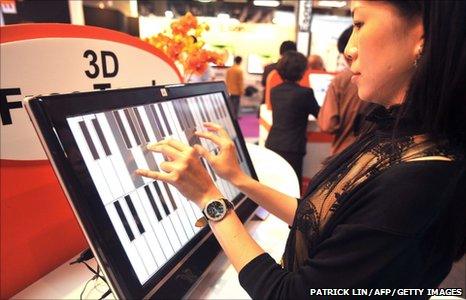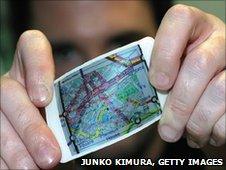Haptics brings a personal touch to technology
- Published

Touch screen has proved popular - but how about a computer that touches back?
When Aldous Huxley described the 'Feelies' of his 1930s satire Brave New World he envisaged a world in which touch would be exploited by the technology of the future as much as vision. How wrong he was.
Of all the senses, touch has been somewhat neglected as a human means of interacting with machines.
Haptics - which could lead to people interacting with virtual objects using a sense of touch or feel - means to change all that. Labs around the world are now racing to close the gap while the first commercial applications are hitting the market.
For the first time people will be actually be able to have a virtual feel of some of the images that are placed before them.
Keeping in touch
A leading advocate of haptics is Russian scientist Dr Ivan Poupyrev, now a senior researcher at Disney Research Labs in Pittsburgh. He claims this area is going to be "huge", particularly for hand-held devices.
"We don't do enough with touch," said Dr Poupyrev.
"The basic goal of the technology we are developing at Disney is to create a perception of texture - to let people 'feel' objects on screen by stroking them with their fingers.
"We do this by applying a high voltage to a transparent electrode on the glass plate - in this case people will feel a texture on the glass. By varying the frequency and amplitude of the signal we can create different sensations."
The results can recreate the feeling of paper or a textile, simulate the smoothness of glass and even the roughness of sand paper.
This work follows on from Dr Poupyrev's earlier research at the Sony labs in Tokyo. The scientist and his team came up with a prototype touch screen for a mobile phone that added a sense of touch in the form of tactile feedback.
"With devices getting smaller and increasingly mobile, I thought it was time we exploited our sense of touch," he said.
"For a start we wanted to create what had never been achieved before - a touch screen that really responded back when you touched it."
Dubbed "TouchEngine", tactile feedback is achieved using tiny bendable strips of crystals known as actuators placed under a thin LCD screen that pulsate slightly when the screen is touched.
It eventually led to a touch panel that generates tactile feedback and also detects the amount of pressure applied to the panel.
If, for example, someone were to apply more pressure to the screen displaying an icon the speed of switching between icons would intensify.
Bendable tech
However, being able to feel feedback though the fingertips from a hand-held screen was just the start.
Ivan Poupyrev also teamed up with designers Carsten Schwesig and Eijiro Mori to develop a bendable credit-card-sized device nicknamed Gummi. The card is activated by the bending motion.
The prototype Gummi uses bendable organic light-emitting display (OLED) technology. Sony claims to have created the world's most flexible OLED so far - so thin and flexible that the colour display can be rolled around a pencil while streaming video.

Maps or photo albums could be made from the bendable media cards
Flexible electronic paper is already on the market in the form of e-readers.
LG Display plans to launch mass-production of an 11.5-inch (29cm) flexible e-paper display "in the near future". The market for more paper-like displays will be substantial according to market researcher DisplaySearch.
Combining haptics with these bendable electronics could give rise to a whole new generation of flexible devices, said Dr Poupyrev.
"[E-reader manufacturer] Plastic Logic has an e-reader where all the driving electronics are built out of plastic transistors. Potentially, it could allow for the creation of a completely flexible device."
The results could resemble the very malleable Gummi.
"Users can control the amount of bending very accurately," said Carsten Schwesig.
"The Gummi GUI contains intuitive bending controls for tasks that exploit this fact, such as zooming in and out of a map, controlling the playback speed of media files and controlling the composition of image layers.
"More information can be displayed on the small screen in the absence of buttons or additional menu hierarchies."
'Next level'
There are already some touch feedback devices in the shops, including Samsung's Haptic phone with its vibrating screen that makes a tick motion when the screen is touched, confirming that it has understood the user's command.
Toshiba recently demoed its "New Sensation UI Solution," which uses E-sense technology from Finnish company Senseg.
E-Sense can produce localised tactile feedback by controlling the electric charge on a film affixed to the touch-panel.
It means users can feel different sensations such as touching wood, metal and soft materials, says Toshiba.
Technologies such as these could take touchscreen technology - such as that used in Apple's iPad - to the "next level", according to Dr Poupyrev.
"iPad allows people to touch virtual objects as though they were real," he said
"Flexibility should take a further step and let people feel them, stretch them, bend them and have them react to these interactions," he said.